Opinion
What Is Leonardo’s ‘Salvator Mundi’ Really Selling? Cracking the $450 Million da Vinci Code
Jesus saves, but the buyer of Leonardo's 'Salvator Mundi' will spend—a lot.
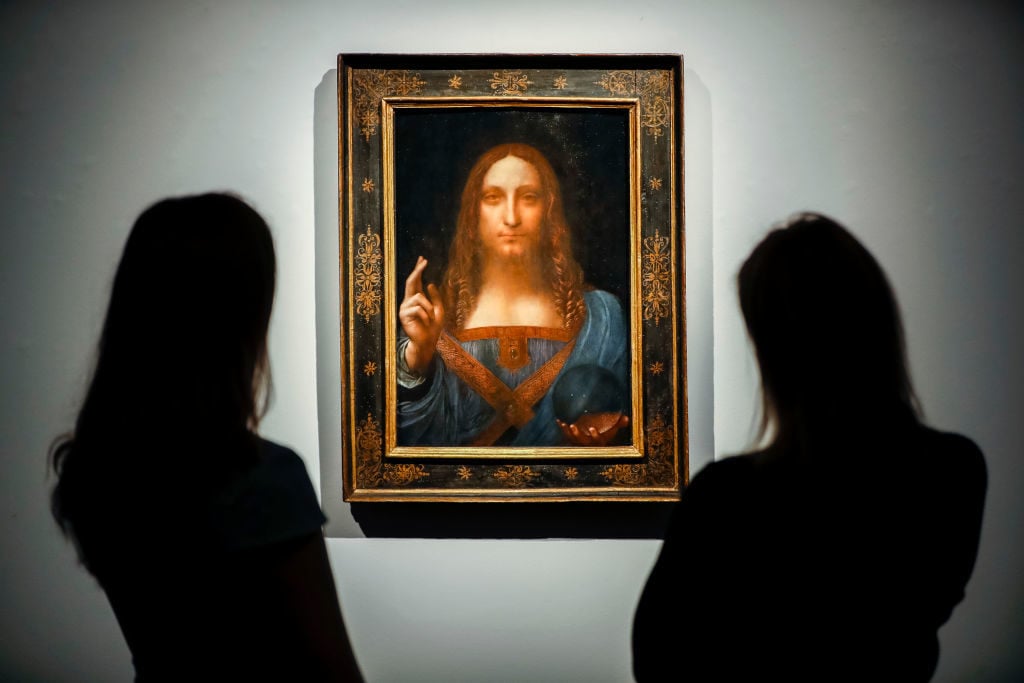
Jesus saves, but the buyer of Leonardo's 'Salvator Mundi' will spend—a lot.

The signs all point one way: Christie’s upcoming sale of Leonardo da Vinci’s spooky Salvator Mundi is the latest and perhaps most convincing portent that we are living in the End Times.
In the Bible, Christ and his apostles held their property in common. Now, this image of Christ as “Savior of the World” will be the ultimate piece of private property, sold in a spectacle of unhinged wealth (the pre-sale estimate is $100 million). As a symbol of society out of balance, the golden calf’s got nothing on the Salvator Mundi. [Update: after this article was published, the painting sold for $450.3 million, a world record.]
“It is easier for a camel to go through the eye of a needle, than for a rich man to enter into the kingdom of God” (Matthew 19:24). Maybe so—but the rich man can buy a form of earthly immortality through association with “the last Leonardo in private hands.”
Lord knows in whose hands, public or private, the Salvator Mundi will end up. I hope it goes somewhere people can see it, because it’s a cool painting, full of oddities and mysteries.
Believed to have been created between the late 1490s and early 1500s, the portrait has a character at once real and unreal. Christ’s unnervingly unreadable expression almost (but not quite) earns the painting its hokey marketing tagline as “The Male Mona Lisa.” It is a naturalistic depiction, sans the crown or conventional gold halo of medieval art: Jesus as a human being. Yet his visage also seems to float in a smoky, chinless mist, in a way that may be meant to suggest the apparition of the Holy Face in Christian icons like the Veil of Saint Veronica.
The facial features are vividly human, yet also subtly alien. No doubt this is partly due to the fact that beneath all the earthly detail, Leonardo has structured the proportions through the composition according to his mathematical obsession with the “golden section.”
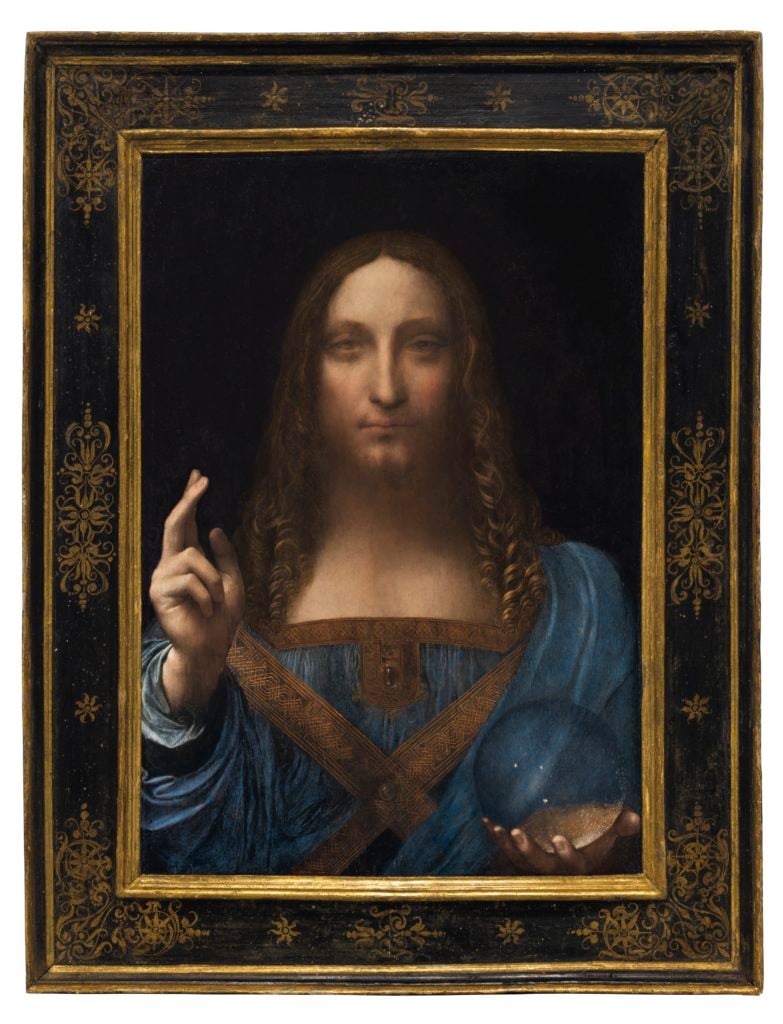
Leonardo da Vinci’s Salvator Mundi. Courtesy of Christie’s Images Ltd. 2017.
It was long known that Leonardo had painted a particularly potent image of Christ, because there were numerous copies of the Salvator Mundi floating around. As for the present work, the first definite record of its existence comes after it entered the collection of Charles I of England.
Tycoons hoping that a proximity to glorious art will cleanse them of their sins, take note: It didn’t work for Charles, who was beheaded for treason in 1649, leaving his famous collection of Renaissance art to be sold by the Commonwealth to pay down his royal debts. That too is part of the inherited symbolism of Salvator Mundi.
From the regicide onward, it’s been a winding road for Leonardo’s Christ. It isn’t totally clear how, but this ghostly rendering of the man from Galilee ended up so disfigured that the painting was long attributed to a follower. This was partly due to an unfortunate makeover: perhaps finding the Renaissance master’s original visage too effete for the son of God, an unknown retoucher added a wispy mustache and slightly shifty facial expression, making Christ look like a teenager trying to bluff his way into a bar. In 1958, what was left of the picture was sold at Sotheby’s for just £45.
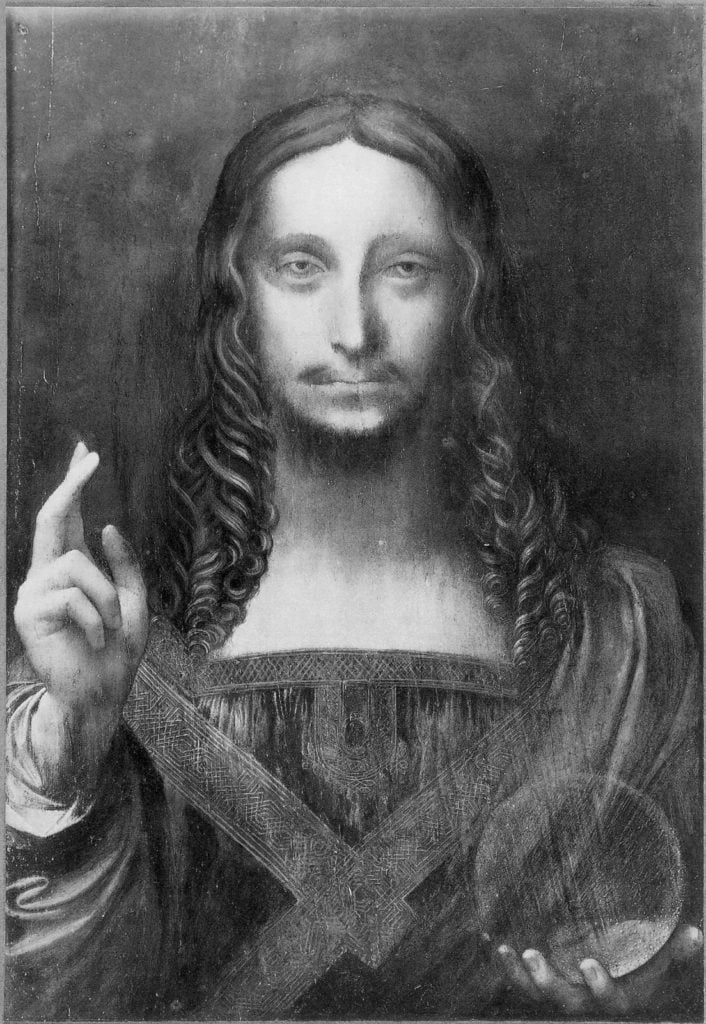
Photo of Leonardo da Vinci’s Salvator Mundi before restoration. Image courtesy Christie’s.
It was only in 2005 that the painting was rediscovered by New York dealer Robert Simon, setting in motion its transubstantiation into true “Lost Leonardo” status. It was unveiled to the world at “Leonardo da Vinci: Painter at the Court of Milan” at the National Gallery in the London in 2011, drawing titanic crowds.
One does not turn up a new painting by Leonardo every day. He is probably the world’s most famous artist, and he didn’t make a lot of paintings. Believe it or not, that eye-popping $100 million auction estimate is already a bit of a comedown for the work. In 2012, Art in America quoted a clutch of unnamed industry insiders saying that it was being shopped around to museums for twice that; the 2011 BBC documentary Da Vinci: The Lost Treasure mentioned an estimate of £125 million, which would also be about $200 million.
It is only because no museum could afford this sum, or because no museum wanted to, that it is now going to the auction block instead.
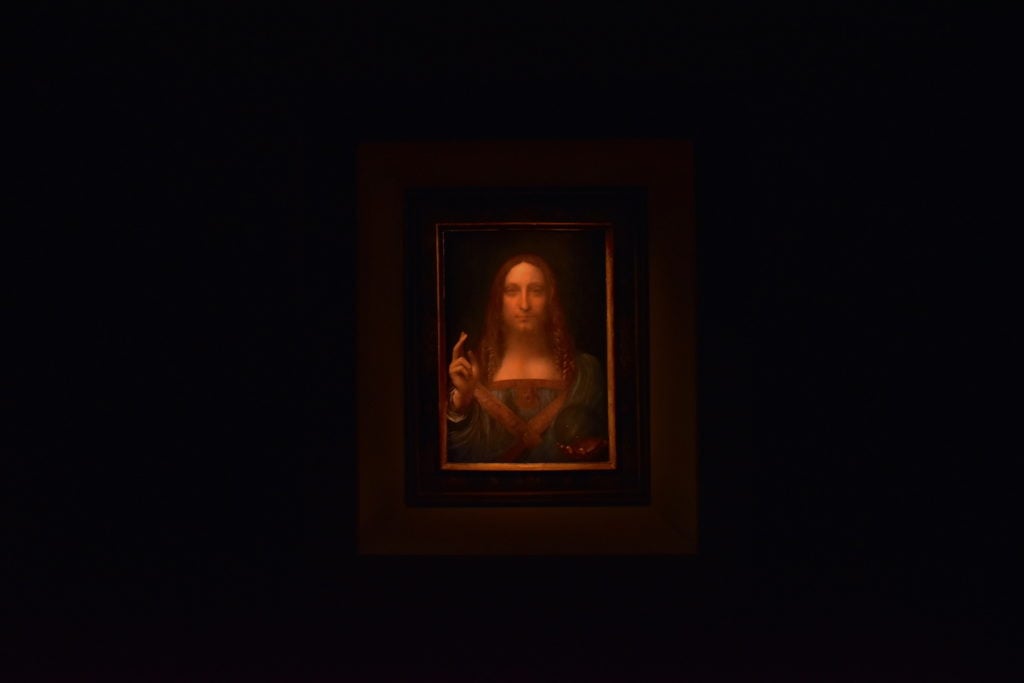
Leonardo da Vinci’s Salvator Mundi on view at Christie’s. Photo: Ben Davis.
The fallen condition of Salvator Mundi may explain some lingering reservations from potential buyers, the museums in particular. According to the painting’s ace restorer, Dianne Dwyer Modestini, the walnut panel on which it was painted was substantially “worm-tunneled.” Pictures of the work in its “cleaned state before restoration” look as if Christ has been hit by a bolt of lightning: a split slashes through the center of the figure’s chest, veering just to the left of his face, bisecting the painting. (In the auction catalogue, you can find that image on page 70, bottom left.)
Since the two halves no longer joined together levelly, someone evidently tried to file down the edges with some type of blade to make them even, scouring off whole sections of paint, sometimes down to “fresh wood,” including Christ’s beautiful curly hair—a Leonardo signature—on the left side. Where Leonardo’s original painting survived, much of the ingeniously delicate detail and intricate modeling had been abraded away, and had to be recreated through Modestini’s informed guesswork.
For what it’s worth, I’ve read Modestini’s very thorough essay on the restoration of Salvator Mundi from the 2014 collection Leonardo da Vinci’s Technical Practice: Paintings, Drawings and Influence. While it provides an intimate account of the agonizing problems inherent to reconstructing what she calls a “lovely but damaged painting,” it also offers plenty of evidence that the portrait’s exceptional qualities remained intact, suggesting the magic aura of an authentic Leonardo da Vinci still glows from within.
Those still inclined to doubt its authenticity have focused attention on the crystal orb, symbol of Christ’s dominion over the Earth. The orb does not realistically refract the image behind it. Leonardo, fascinated with optics, would have done better, the argument goes.
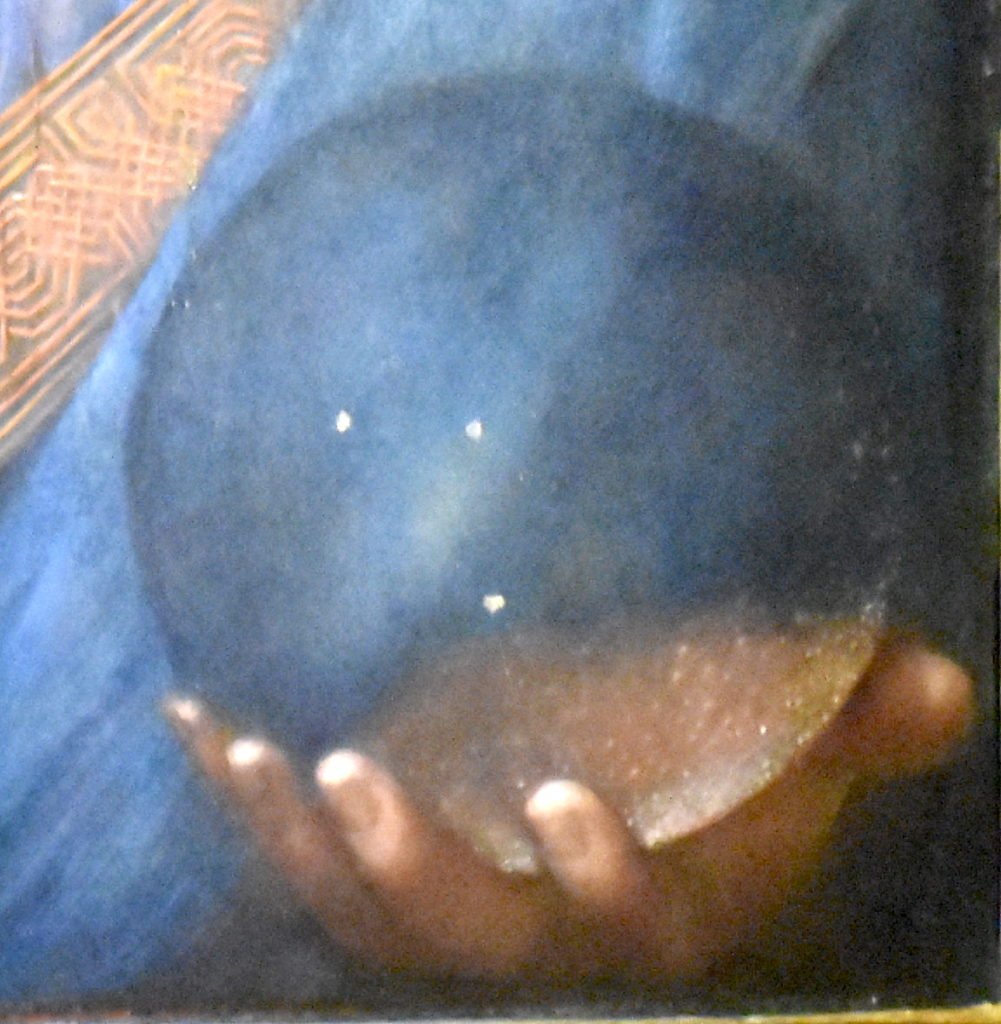
Detail of Leonardo da Vinci’s Salvator Mundi. Image: Ben Davis.
The depiction of the rock crystal is otherwise incredibly detailed, down to the imperfections. So a counter-theory is that its unnatural character is one of a number of subtle effects in the painting that convey Christ’s otherworldly nature. You can imagine that the orb’s uneasy amalgam of realistic and fantasy properties subtly implies the dual nature of Christ as God and Man, if you like.
I say “if you like” because such fevered fan theories are part of the Leonardo cult. His mythic cachet is, in truth, only half about the refinement of the actual work. The other half comes from the media aura of divine Renaissance genius built up around him, from The Lives of the Artists to The Da Vinci Code to the BBC’s wacky kids show Leonardo, which adds parkour to his Renaissance Man superpowers.
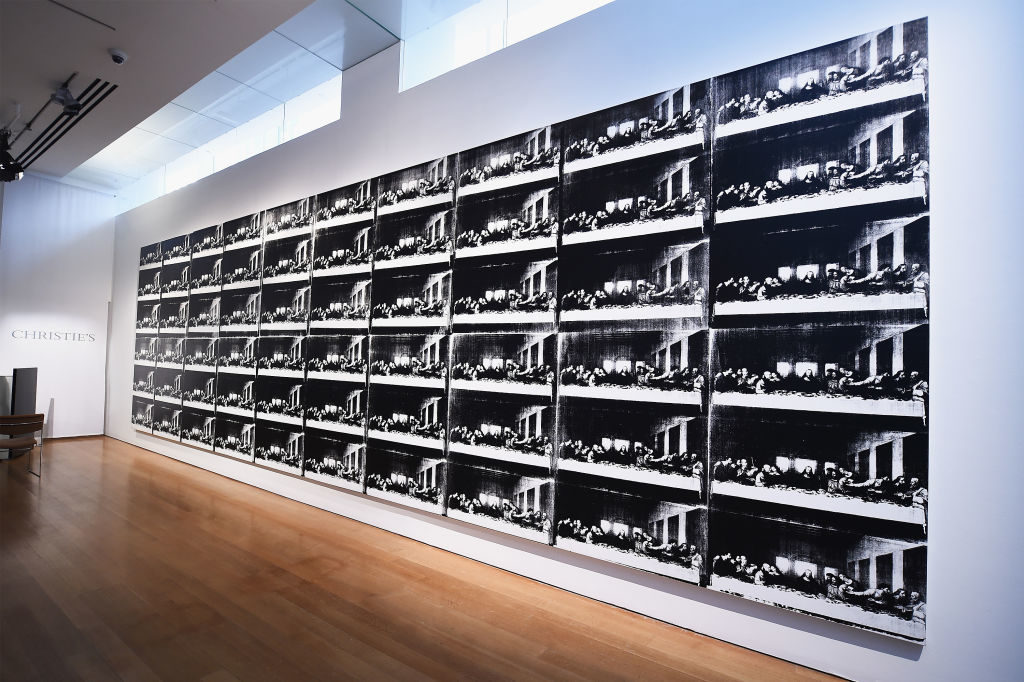
Christie’s unveils Andy Warhol’s Sixty Last Suppers (pictured) at Christie’s New York on October 10, 2017 in New York City. Photo by Ilya S. Savenok/Getty Images for Christie’s Auction House.
Christie’s very much knows that that its desired audience may be more engaged with the fantastical idea of Leonardo than actual, old-school Renaissance connoisseurship. In a manner that seems half slyly knowing and half crassly clueless, such is the message sent by the fact that Salvator Mundi is being sold in a contemporary art sale, paired with an Andy Warhol painting of Sixty Last Suppers. When you get right down to it, Warhol’s work is about how the holiest of art has become, in contemporary conditions, a brand bleached of deep meaning.
The Salvator Mundi auction catalogue even includes a chapter called “The First Last Supper: The Beginning of Mona Mania,” about the rise of the media frenzy around Leonardo. The Mona Lisa’s eternal status was cemented by its blockbuster 1962 tour of the US, a media event Christie’s has tried to echo with its own Salvator Mundi roadshow, complete with a strange commercial (and dedicated @thelastdavinci Instagram feed) featuring hidden camera footage of viewers transfixed by the painting.
Of the Mona Lisa‘s trip to the US, the catalogue quotes Warhol: “Why don’t they have someone copy it and send the copy, no one would know the difference.” Given the fact that the auction house is trying to sell a painting that has had so much cosmetic work, that’s a pretty telling quote. All told, you are definitely being sold something that is part painting, part story.
And yet, it’s worth admitting that there is something special about Leonardo, not just as a painter, but as a media object. There’s a reason he functions so well as a screen for the more febrile, occult, conspiracy-obsessed side of the contemporary imagination.
We associate the Italian Renaissance with the birth of the heroic genius artist, yet the Renaissance didn’t have anything like our modern idea of art as personal expression, which is a product of the Romantics. The result is that, on the one hand, Leonardo stands in the mind as a masterful artistic visionary; and yet, his symbolism is not really self-invented or personal in the modern way. In Salvator Mundi, his subject matter was likely a commission from the French royal family; his imagery, for all its resonant flourishes, is an intelligent synthesis of traditional tropes.
Lose the sense of a larger-than-life individual and you have just boring old devotional art; lose the esoteric symbolism and you don’t get the feverish sense of every detail being a code for something with higher, cosmic significance. Leonardo is, like his Christ, at once recognizably like us and a bit otherworldly.
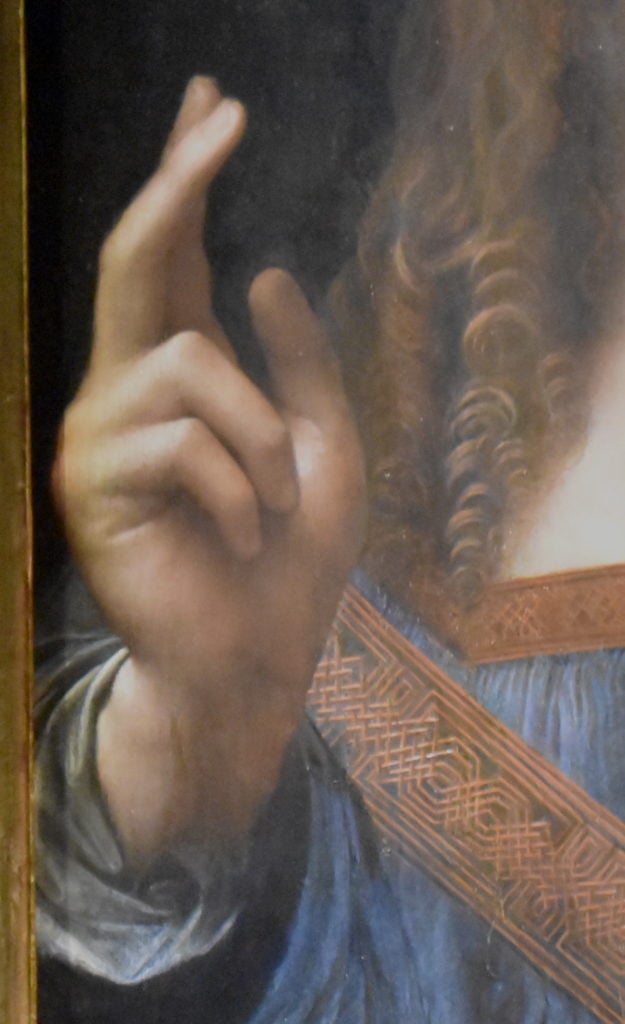
Detail of Leonardo da Vinci’s Salvator Mundi. Image: Ben Davis.
In Salvator Mundi specifically, some of the symbolism truly is just convention. The three upraised fingers of Jesus’s gorgeously rendered blessing hand, for instance, represent the Trinity. But that number is mirrored in the three floating dots of eerie light in the crystal ball, a much more magical touch.
I’ve read it suggested that the eight-pointed star, seen at the intersection of the two straps of his stole, is also significant. Eight is the number of the Resurrection.
The elaborate braided knotwork of Christ’s garment was Leonardo’s invention (it may have been influenced by Islamic patterns). The apparent complexity of his design is formed, ultimately, of a single, unbroken golden thread. The infinite knot, here as elsewhere in Renaissance art, is a symbol of eternity.
Now, here’s a more out-there theory: If you look at the crossing of Christ’s stole, just to the left (Christ’s right side), there is a disturbance in the folds of the otherwise elegantly draped fabric. It resembles a gash, and would sit over the place where a Roman soldier pierced Jesus’s torso with a lance during the crucifixion.
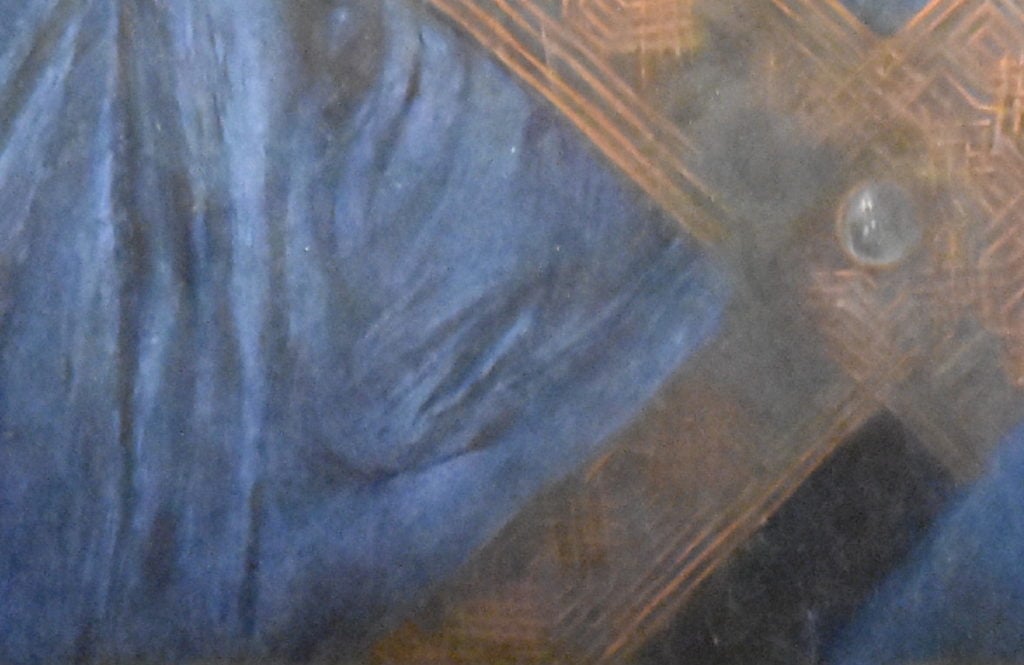
Detail of Leonardo da Vinci’s Salvator Mundi. Photo: Ben Davis.
Too much of a reach? The eccentrically emphasized fold is definitely part of the plan in Leonardo’s red chalk studies for Salvator Mundi in the Royal Library at Windsor collection. (Joanne Snow-Smith came up with the “hidden wound” theory in a 1983 book that made the case for another version of the Salvator Mundi image as Leonardo’s original; that work, formerly in the collection of the Marquis de Ganay, features the weirdly exaggerated fold suggested by the Windsor sketch much more clearly.)
But since we are invited to mythologize the infinite profundity of Leonardo, let me go the full Dan Brown and unveil for you my own bit of Salvator Mundi fan fiction.
The crack that split the painting in two has, Modestini has written, a single origin: A knot in the walnut panel that it’s painted on. Leonardo sited that flaw right near the hidden wound and around the eight-pointed star of Resurrection that lies at the crossing of the two straps of Jesus’s priestly garment, the so-called Stole of Immortality.
In other words, the source of the painting’s earthly decay radiates from the very center of the symbolism of His immortal nature!
But what could better capture the essence of a Christ who became mortal and died to redeem the sins of humanity than a painting that both gave body to the divinity and was designed to self-destruct? Surely this is the prophetic message that the divine Leonardo has left us, Nostradamus-like, in his painting!
![Loic Gouzer [center] speaks as Christie's unveils Leonardo da Vinci's Salvator Mundi with Andy Warhol's Sixty Last Suppers at Christie's New York on October 10, 2017 in New York City. Photo by Ilya S. Savenok/Getty Images for Christie's Auction House.](https://news.artnet.com/app/news-upload/2017/10/christies-press-conference-salvator-mundi-1024x682.jpg)
Loic Gouzer [center] speaks as Christie’s unveils Leonardo da Vinci’s Salvator Mundi with Andy Warhol’s Sixty Last Suppers at Christie’s New York on October 10, 2017 in New York City. Photo by Ilya S. Savenok/Getty Images for Christie’s Auction House.